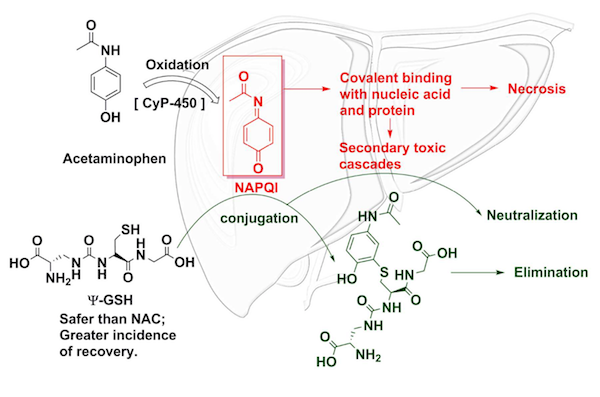

Check LFTs and INR q12h if ALT>1000, also check BMP q12h to monitor for renal failure.Call Poison Control (80) for further guidance.Antiemetics: ondansetron, metoclopramide especially important to give with PO NAC.APAP ingestion with any evidence of liver injury.Serum APAP >10mcg/mL for unknown time of ingestion.If evidence of liver failure (INR>2), 20-hour IV protocol + continuous infusion until INR150mg/kg or >7.5g regardless of weight. If no evidence of liver failure, 20-hour IV protocol (150mg/kg IV loading dose in the first hour). IV dosing: can give IV if unable to tolerate PO/NG.
ACETAMINOPHEN ANTIDOTE FULL
If patient vomits within 1 hour of administration, immediately give full dose again.
Oral dosing: 140mg/kg loading dose, followed by 17 doses of 70mg/kg q4h (72 hours). Best if given within 8 hours of ingestion and before ALT rise. N-acetylcysteine (NAC): low threshold to treat, given low toxicity and cost. May be helpful >4h if co-ingestion is present. Activated charcoal: single dose activated charcoal at 1g/kg (or 50g) PO or via NG tube to all patients within 4 hours of ingestion. Note that very elevated bilirubin or creatinine can cause false positive acetaminophen level if any doubt, treat as true positive. It assumes rapid absorption, so may be unreliable when absorption is delayed by sustained-release formulation, co-ingestion of opioids, or anticholinergic drugs. Note that the nomogram is only validated for a single ingestion with a known time of ingestion, and is not accurate in cases of repeat or chronic ingestion. Evaluate 4-hour serum concentration on Rumack-Matthew nomogram: if value is above the treatment line, NAC should be administered. Obtain BMP, LFTs, coagulation factors, urinalysis, urine toxicology consider other causes of acute liver failure. Obtain serum acetaminophen concentration immediately and at 4 hours from ingestion (if known) or presentation (if not known). If possible, determine dose, single ingestion or recurrent, time since ingestion, intentional vs accidental, baseline liver disease or risk factors. Resolution of symptoms and labs may take longer. Usually is complete by 7 days post-ingestion, but can be prolonged in very ill patients. Stage IV – 96 hours-2 weeks: recovery phase. If death occurs, it is in this stage, usually from multiorgan failure. Patients with severe hepatotoxicity will have transaminases >10K, increased INR, hypoglycemia, lactic acidosis, total bilirubin >4. Stage III – 72-96 hours: same symptoms as in stage I return, along with jaundice, hepatic encephalopathy, drastic LFT rise, elevated ammonia, and coagulopathy. Abnormalities in renal function and coagulopathy may also begin to appear. Will develop RUQ pain, tenderness, and liver enlargement. Stage II – 24-72 hours: stage I symptoms may improve, but laboratory values will worsen, with elevated hepatic aminotransferases (usually AST first, then ALT) by 36 hours. Serum aminotransferases are often normal, but can rise as early as 8-12h after massive ingestion. Massive ingestions (e.g., serum levels >500 mg/L) can cause acute CNS depression, AGMA, and hypotension. Stage I – 0-24 hours: anorexia, nausea, vomiting, diaphoresis, lethargy, malaise, pallor may also be asymptomatic, especially early. Sudafed) can lead to accidental overdose. Percocet) and as part of many over the counter cold medications (e.g. Acetaminophen is found in combination with opioids (e.g. Kidneys also have P450 enzymes and can sustain damage from toxic intermediates. Toxicity is worsened by starvation (low glutathione) and chronic alcohol use (induces P450 enzymes which creates more toxic metabolites). Toxicity is likely in adults after single, acute ingestion of >250mg/kg or >12g per 24h blood level >150 mg/L after 4 hours is toxic and will require treatment. N-acetylcysteine (NAC, Mucomyst®) works by repleting glutathione, enhancing sulfate conjugation, and may directly bind to NAPQI. 
Overdose will lead to excess NAPQI, which depletes glutathione supply, and reactive intermediates damage hepatocytes. Normally safely metabolized by glucuronidation and sulfonation (>90%) even at appropriate doses a small fraction will be metabolized to a highly toxic reactive intermediate (NAPQI), which is normally detoxified by conjugation with glutathione for renal excretion. Acetaminophen is absorbed by the duodenum metabolized by the liver.






 0 kommentar(er)
0 kommentar(er)
